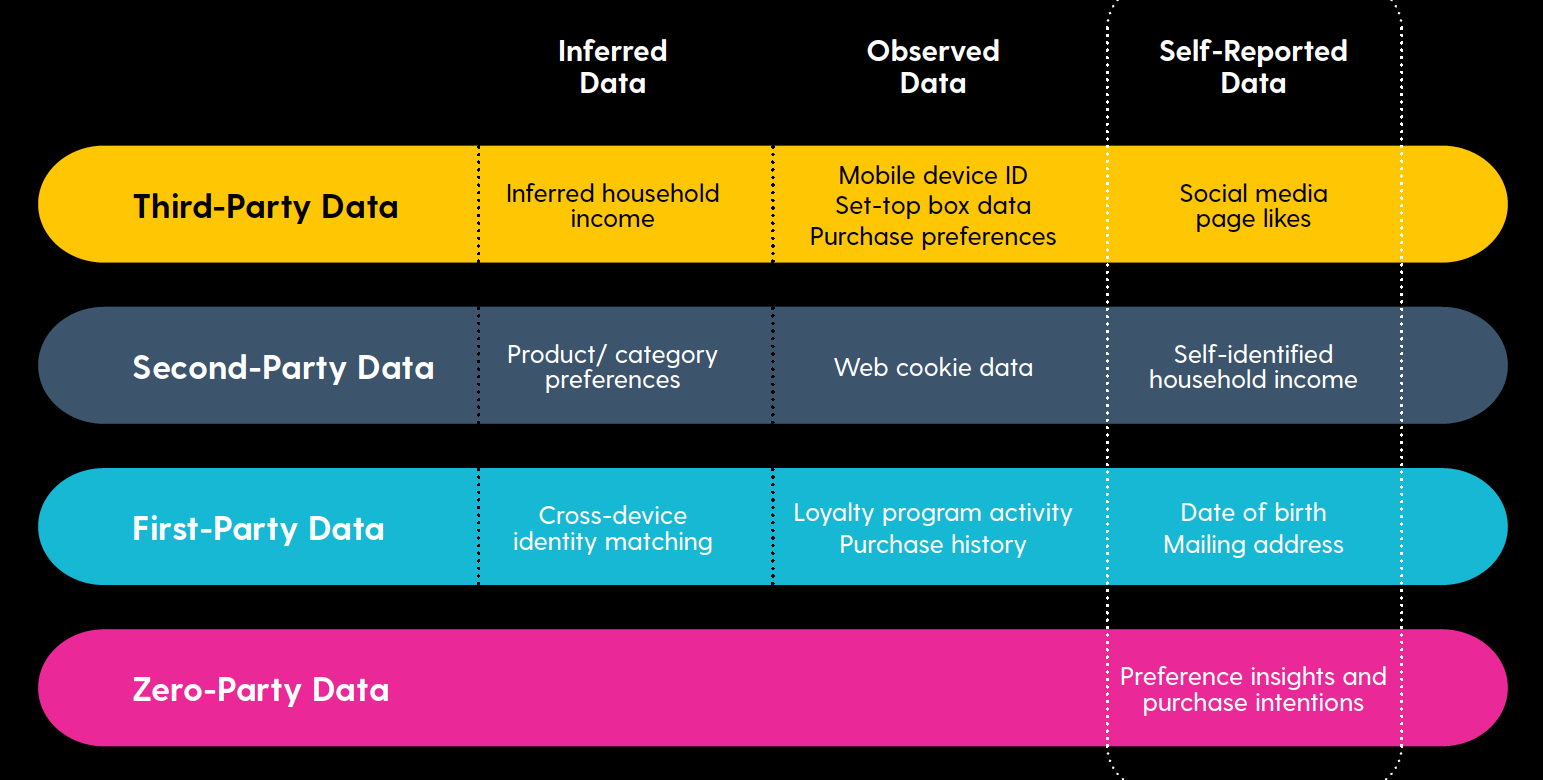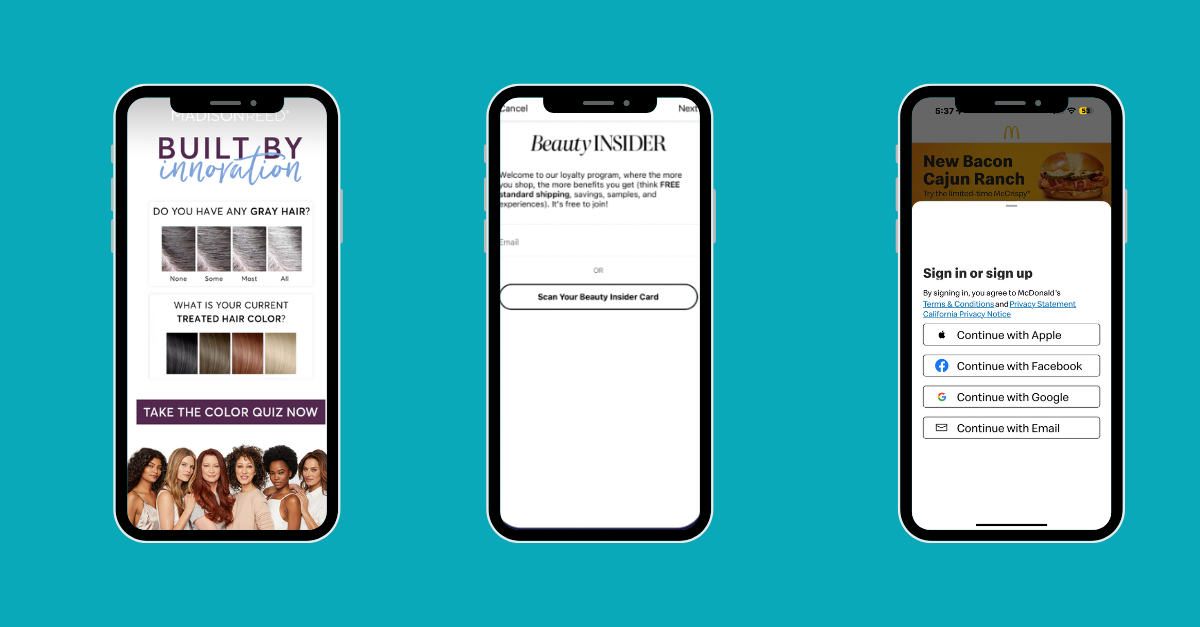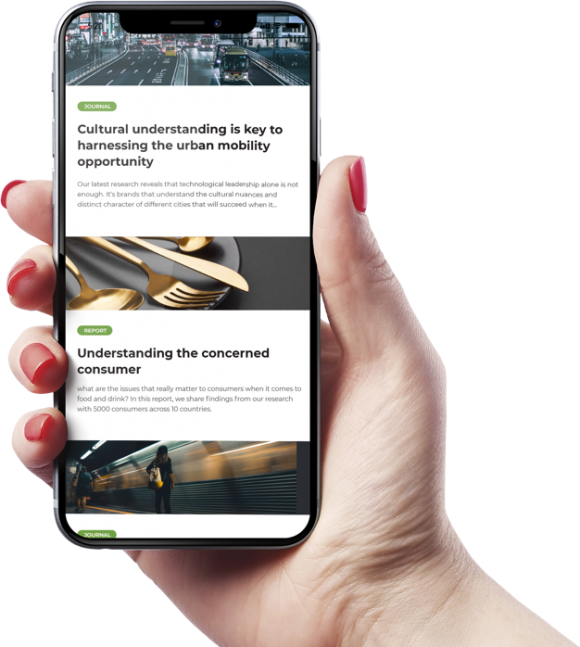The quest for meaningful customer data has become a high-stakes treasure hunt. Marketers find themselves at a crossroads as traditional data sources begin to dry up, thanks in part to growing consumer concerns over privacy and significant moves like Google’s phase-out of third-party cookies. Yet, amidst this shifting terrain lies a goldmine of data: the information customers willingly share with brands, known as zero-party data.
Imagine having a crystal ball that lets you peek into your customers’ preferences, interests, and desires without overstepping privacy boundaries. That’s the power of zero-party data. It’s like having a direct line to what your audience really wants, giving you the insights needed to craft personalized experiences that hit the mark every time.
37% of consumers not only welcome but prefer personalized services based on data they’ve shared.
In a marketplace increasingly governed by strict privacy regulations and where consumer expectations are higher than ever, zero-party data emerges as a frontrunner. It’s not just about staying on the right side of the law; it’s about building a foundation of trust and engagement with your audience. By prioritizing zero-party data, brands can confidently navigate the future of marketing, ensuring their strategies are compliant and genuinely resonate with their customers.
What is Zero-Party Data?
Zero-party data is information that customers intentionally and proactively share with brands. As brands navigate the shifts in data privacy and consumer preferences, zero-party data is a strategic asset central to building customer trust and delivering personalized experiences.
Zero-party data refers to information that consumers willingly and proactively share with brands, typically in exchange for a personalized experience or service. This type of data is explicitly provided by the customer and includes preferences, purchase intentions, personal context, and how they wish to be recognized by the brand. For instance, a customer may fill out a profile on a skincare company’s website, specifying their skin concerns and product preferences, or a shopper may set dietary preferences in a grocery app to receive tailored shopping suggestions.
Comparison with Other Types of Data:

Image credit: Conversion Giant
- First-party data is gathered directly from customer interactions with a company’s channels, like website visits, purchases, or customer service engagements. It is collected passively, although with consent, often without the same level of proactive intent as zero-party data.
- Second-party data is essentially first-party data that another entity shares directly. It comes from a known and trusted source but does not originate from the company using it.
- Third-party data is bought from external sources that did not originally collect data from your customers. This data is typically used to augment a company’s understanding of its customers, but it is less reliable and is now more regulated.
The distinction is crucial: zero-party data is given by customers with a clear understanding and intention of how it will be used, making it a gold standard for trust and relevance.
Zero-party data is unique because it is collected with the customer’s full cooperation and transparency, reflecting explicit preferences and needs. This makes it incredibly valuable for creating highly personalized marketing strategies that resonate well with the target audience.
The Rising Importance of Zero-Party Data
In a privacy-conscious world, the emphasis on zero-party data is a strategic pivot. Global data protection regulations, such as the General Data Protection Regulation (GDPR) in Europe and the California Consumer Privacy Act (CCPA) in the U.S., have reshaped how data can be legally collected and used, putting consumer privacy at the forefront of business operations.
These shifts have enhanced the value of zero-party data and prompted brands to rethink how they engage with customers, ensuring transparency and consent are at the core of their data collection practices. This fundamental change drives a new marketing and customer relationship management era, where personalization is linked directly to consumer trust and empowerment.
Zero-party data is a compliance necessity and a competitive edge that aligns closely with customer expectations, offering a pathway to deeper engagement and sustained business growth.
The Evolution of Data Privacy
Digital marketing has undergone a radical transformation over the last decade, mainly driven by sweeping changes in privacy laws and a shift in consumer attitudes toward data privacy.
Historical Context: The Shift from Third-Party Data
Traditionally, marketers relied heavily on third-party data, harvested without direct user engagement and often without their knowledge, to tailor marketing strategies. This data was a cornerstone of digital advertising, enabling brands to target ads based on detailed user profiles sourced from third parties.
However, this approach faced a significant overhaul with the introduction of stringent privacy regulations such as the General Data Protection Regulation (GDPR) in 2018 and the California Consumer Privacy Act (CCPA) in 2020. These laws mandated that companies gain explicit consent from consumers before collecting or using their data, dramatically reducing the availability of third-party data.
Consumer Awareness and Attitudes Toward Privacy and Data Security
As data breaches and privacy scandals became headline news, consumer awareness and concern about privacy issues soared. A Pew Research study found that 79% of consumers are concerned about how companies use their data. This growing skepticism has fueled a demand for greater transparency and control over personal information, leading consumers to favor brands that respect their privacy and provide clear value in exchange for their data.
Impact of Privacy Changes on Traditional Marketing Strategies
The tightening of privacy regulations and the shift in consumer sentiment have profoundly impacted traditional marketing strategies. The depletion of third-party data sources has forced marketers to pivot towards more ethical and sustainable data practices. This shift is evident in the rising importance of first-party and zero-party data, where the emphasis is on quality over quantity—collecting less data but of higher relevance and with explicit consent.
Marketers are now investing in building direct relationships with consumers, encouraging them to share information directly through engaging and interactive platforms. This shift complies with new privacy norms and builds a foundation for deeper customer loyalty and trust. The focus has moved from broad, impersonal ad targeting to creating personalized experiences openly shared and controlled by the user, marking a significant evolution in how brands interact with their audiences.
This transformation involves adjusting compliance and strategically reorienting toward more meaningful, consent-based customer interactions. This can lead to sustainable brand growth and a more robust, trust-based customer relationship.
How to Collect and Implement Zero-Party Data
Collecting and implementing zero-party data effectively hinges on engaging the customer in a rewarding rather than intrusive way. It involves gathering information directly from your customers and offering them something of value in return. This exchange helps ensure that the data you receive is relevant and willingly provided, enhancing trust and engagement.
Collecting Zero-Party Data
The key to effective zero-party data collection is to offer consumers something valuable in exchange for their information. This could include:
- Discounts: Offering a percentage off their next purchase or exclusive member discounts can motivate customers to share their preferences.
- Ebooks and Educational Content: Providing informative ebooks or access to exclusive webinars can attract customers interested in your industry and willing to exchange their data for knowledge.
- Newsletter Sign-Ups: Encourage customers to sign up for your newsletters with the promise of timely information, insights, or offers tailored to their interests.
- Customized Product Recommendations: Allow customers to fill out profiles detailing their preferences to receive personalized product suggestions that meet their needs.
Implementing Zero-Party Data
- Email Marketing:
- Utilize the collected data to send personalized emails that resonate with each customer’s preferences and previous behaviors. This approach makes your communications more relevant and increases the likelihood that customers will engage with your emails rather than ignore them.
- Cross-sell products based on detailed shopping habits and explicit interests that customers have shared. This targeted strategy ensures that your offers are timely and appealing to each recipient.
- Social Media Retargeting:
- Custom Audiences: Use platforms like Facebook to import your zero-party data to create custom audience segments. This allows you to retarget existing customers with ads tailored to their preferences and behaviors.
- Lookalike Audiences: Expand your reach by using zero-party data to identify new potential customers who share similar characteristics with your best existing customers. This method can significantly increase the efficiency of your ad spend by targeting new users who are more likely to be interested in your products.

Other effective methods:
- Surveys and Polls: Designed to be engaging and informative, these tools can gather specific insights about the preferences and interests of customers.
- Interactive Content: Quizzes, configurators, and preference centers that allow customers to customize their experiences to engage users and provide deep insights into their preferences and intentions.
- Direct Customer Interactions: Engaging with customers through customer service or during in-store visits can also be an excellent opportunity to gather zero-party data, as customers often share information and feedback that can be used to enhance their experience.
Benefits of Zero-Party Data
The strategic value of zero-party data extends far beyond compliance with privacy regulations. It fundamentally enhances how brands interact with customers, offering numerous benefits in a competitive market.
Enhanced Personalization and Customer Experience
- Tailored Recommendations: By directly obtaining consumer preferences, brands can tailor product recommendations, services, and content to fit each customer’s unique needs and desires, leading to higher satisfaction and engagement.
- Customized Marketing Messages: Campaigns and messages can be customized based on the customer’s explicit interests, ensuring marketing efforts are more relevant and less likely to be perceived as spam.
- Dynamic Personalization: Real-time data input from customers allows brands to adjust experiences, enhancing the customer’s journey at each touchpoint based on their current needs and preferences.
Building Trust and Transparency with Customers
52% of consumers stated they are more likely to purchase from a brand that allows them to control how their data is used.
- Transparent Value Exchange: When customers provide data, they do so with the expectation of receiving something in return. This transparent value exchange enhances trust, as customers directly benefit from sharing their information.
- Consent-Based Relationships: Since zero-party data is provided willingly by customers, it establishes a consent-based relationship from the start, reinforcing trust and respect for the customer’s privacy.
- Transparency in Data Use: By using data customers have explicitly shared for specific purposes; brands can maintain high levels of transparency about how customer information is being used, further building trust.
Improving the Accuracy and Relevance of Marketing Efforts
- Higher Data Quality: Zero-party data is accurate and highly relevant because it comes directly from the customers regarding their interests and needs, reducing reliance on assumptions or outdated information.
- Efficient Resource Allocation: With more accurate data, companies can allocate marketing resources more efficiently, focusing on highly targeted campaigns that will likely yield better results.
- Improved Customer Insights: Customers’ direct data can offer deeper insights into customer behavior and preferences, enabling companies to develop better products, services, and marketing strategies that truly meet their audience’s needs.
Zero-party data meets the requirements of privacy-first marketing and drives significant improvements in customer engagement, trust, and overall business performance.
Challenges and Considerations
While zero-party data offers significant advantages, collecting and utilizing this type of data also presents several challenges that organizations must navigate carefully to maximize its benefits.
The Complexity of Collecting Zero-Party Data Effectively
- Engagement Design: Crafting interactions that effectively encourage customers to share their data requires thoughtful design. This includes creating engaging surveys, quizzes, and interactive content that provide value to the customer and align with the brand’s identity and customer experience goals.
- Incentivization: Determining the right incentives for customers to share their data can be challenging. Incentives must be appealing and appropriate to the value of the requested information without undermining the perceived value of the products or services offered.
Balancing Data Collection with User Experience
- Seamlessness: Integrating data collection into the customer experience is crucial without disrupting it. Poorly executed integrations can detract from the user experience or lead to frustration, which might deter customers from engaging fully.
- Relevance: It is key to ask for relevant data at the right time in the customer journey. Irrelevant questions or poorly timed data collection can alienate customers and reduce the effectiveness of personalization efforts.
Technical and Organizational Challenges
- Data Storage and Processing: Managing zero-party data requires robust IT infrastructure. The data must be stored securely and processed efficiently to be used effectively in personalization strategies.
- Privacy Compliance: Adhering to data protection regulations (like GDPR and CCPA) is essential. This includes ensuring that data is collected, stored, and used in compliance with these laws, often requiring continuous monitoring and updates to data handling practices.
- Integration with Existing Data Systems: Integrating zero-party data with existing first and second-party data systems can be complex. Organizations must ensure that all data sources communicate seamlessly to create a unified view of the customer that can be used across various business functions.
- Scalability: As companies grow, so does the amount of zero-party data they collect. A significant technical challenge is ensuring systems are scalable and can handle increased data loads without performance degradation.
Market Research Insights
Market research provides a deeper insight into how brands successfully navigate zero-party data by providing deep insights into consumer attitudes toward data sharing.
The strategic implementation of zero-party data is becoming increasingly prevalent across various industries, driven by its ability to enhance personalization and customer trust.
Sephora is a retail beauty brand that uses zero-party data collection to improve customer engagement and retention. Its Beauty Insider program encourages customers to share information about their skin type, beauty habits, and preferences in exchange for personalized recommendations, free cosmetics, and a birthday gift.
Similarly, streaming giant Netflix uses zero-party data to understand user preferences, viewing habits, and content interests, which it then uses to provide personalized recommendations. For example, when you create a Netflix account and fill out a survey about what kind of movies you like, you’re giving Netflix zero-party data. Netflix also collects zero-party data when you add something to “My List,” which adds those attributes to your profile. If you get enough shows added, Netflix presents you with a category.
A study found that 64% of consumers are likelier to recommend a brand that offers a highly personalized experience.
Trends in Consumer Willingness to Share Zero-Party Data
- Increasing Willingness Over Time: There has been a noticeable increase in consumer willingness to share personal information directly with brands, especially when there is a clear understanding of how the data will be used to improve their experience.
- Conditionality Based on Trust: Consumers are more inclined to share data with trusted brands when there is transparency about data usage. This trend indicates that building a reputation for respecting and securely managing customer data is crucial for companies.
- Preference for Control: Recent trends also show that consumers prefer mechanisms that allow them to control their data. Features like preference centers, where customers can update their data and control how it’s used, are becoming popular and are highly effective in increasing customer engagement and trust.
Future Outlook of zero-party data
The future may also shift toward a more interactive dialogue between consumers and brands, where data exchange becomes part of an ongoing relationship rather than a one-time transaction. This will require brands to continuously innovate how they engage with customers, ensuring that data exchange always results in enhanced value for both parties. Data collection methods integrate more seamlessly into AR and VR experiences, making the process more engaging and less intrusive.
As we look ahead, the utilization of zero-party data is poised to continue and expand in scope and sophistication. Emerging technologies such as artificial intelligence and machine learning are expected to play a pivotal role in processing and utilizing zero-party data, enabling even more personalized and dynamic customer experiences. As consumers become more privacy-savvy and regulatory pressures increase, the reliance on zero-party data will become a cornerstone for sustainable marketing practices. Brands that are early adopters of this approach will likely see themselves at a competitive advantage, as they will be better positioned to meet evolving customer expectations for personalized interactions without compromising on privacy.




